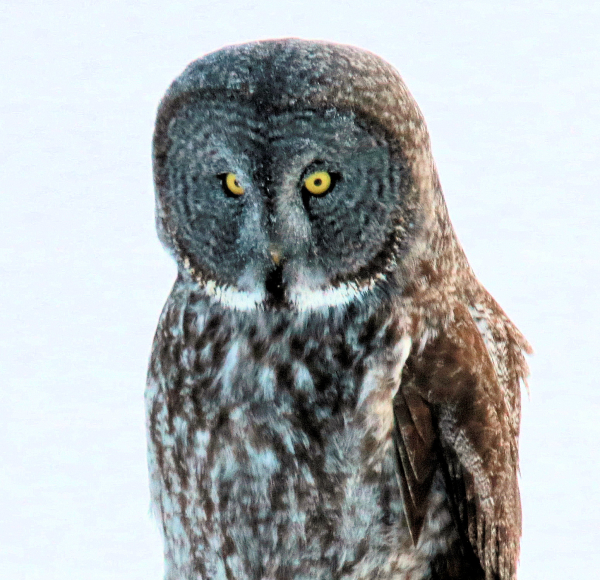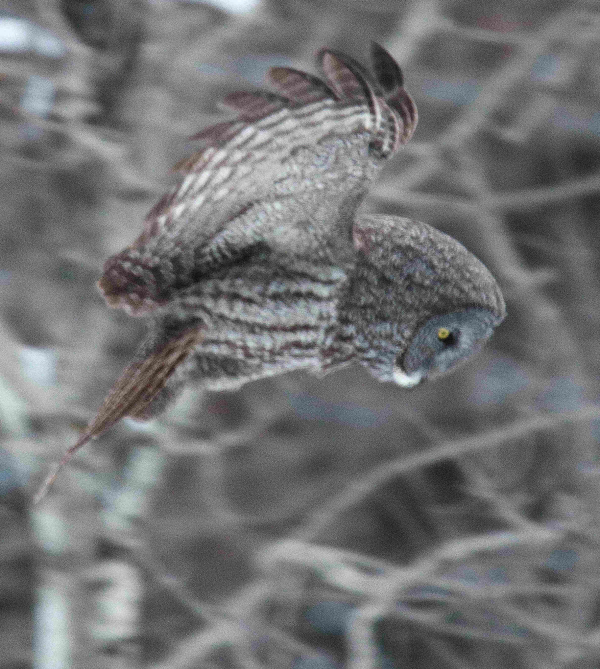
The large specially adapted facial disc of a Great Gray Owl helps to direct sounds to their ears, which provide focused hearing (photos by Paul Konrad).

A Great Gray Owl in hovering flight just before dropping down to catch prey beneath the surface of winter snow.
|
Hovering over potential prey helps Great Gray Owls pinpoint mouse-like voles hidden beneath as much as 2 feet of snow. Several of the owls’ physical features, especially parts of their face and wings, help them correct for sound distortions caused by the snow, enabling them to pinpoint the location of prey moving beneath the snow with astonishing accuracy according to a new study. While most owls fly straight at their prey, Great Grays often hover just above a prey animal before dropping straight down and punching through the snow with their feet to catch prey, usually small voles.
“These aren’t the only birds that hunt this way, but in some ways they are the most extreme because they can locate prey so far beneath the snow cover,” said University of California-Riverside biologist Christopher Clark, who led the study. “This species is THE snow hunting specialist.”
Clark and his team conducted a series of experiments in the forests of Manitoba this year to better understand the owls’ precision despite snow-limited visibility and sound. Their observations are reported in a new Proceedings of the Royal Society B paper.
A key discovery relates to Great Gray Owls’ broad facial disc, which funnels sound toward their ears. Bigger facial discs are more sensitive to low-frequency sounds, so with the largest facial disc of any bird, Great Gray Owls are built for hunting voles, their preferred food. A Great Gray can clearly hear a vole digging and chewing vegetation beneath the snow by pointing their facial disc like a big radar dish.
To demonstrate how snow affects the voles’ sounds, the researchers dug into the snow next to holes in the snow they watched the owls create with their feet while making a hunting strike. Inside the researchers’ holes, they placed speakers that played white noise, which is high-frequency sound, as well as recordings of voles burrowing in snow, which are low-frequency sounds.
Sounds emerging from the snowpack from 6 different depths were recorded by an acoustic recorder composed of multiple microphones. Analysis revealed that low-frequency noises transmitted best, and that only sounds of 3 kilohertz or lower transmitted through 20-inch-thick layers of snow; no high-frequency sounds were detected. “The fact that low-frequency sound passes through snow explains the facial disc of this species, because they have better low-frequency hearing with such a big disc,” added Clark.
The group’s sonic experiments also demonstrated that snow bends the vole sounds, creating an “acoustic mirage,” which could lead owls off target. While spending a moment hovering directly above their prey, the birds correct for the snow’s sound distortions. “The distance the sound has to travel from just overhead is shorter, and there is less snow for the sound to travel through from that position,” Clark said. “This definitely helps the owls land where they need to.”
Great Gray Owls also have specially adapted wings that reduce the sound of their wingbeats while flying, which may help them concentrate on the sounds created by the voles. Among all owls, Great Grays are among the quietest in flight, owing to long fringed wing feathers that have velvet-like parts that muffle the sound of feathers brushing against one another while flying. These qualities are probably very useful during the hovering phase of the hunt.
This last aspect of the work is not only of interest to people fascinated by owls, but also to engineers working to develop quieter machines. For example: “Between the 1940s and ‘60s, airplane sounds were reduced dramatically, but since then planes haven’t become much quieter. Studying how these owls’ wings function could help inspire new planes and drones that create less noise,” Clark suggested.
To observe videos of Great Gray Owls in flight and catching voles in winter snow, you can view https://youtu.be/TWr6ABtlO0Q
To refer to the original article in ScienceDaily, see How giant-faced owls snag voles hidden in snow: Great gray predators rely on sound, not sight -- ScienceDaily